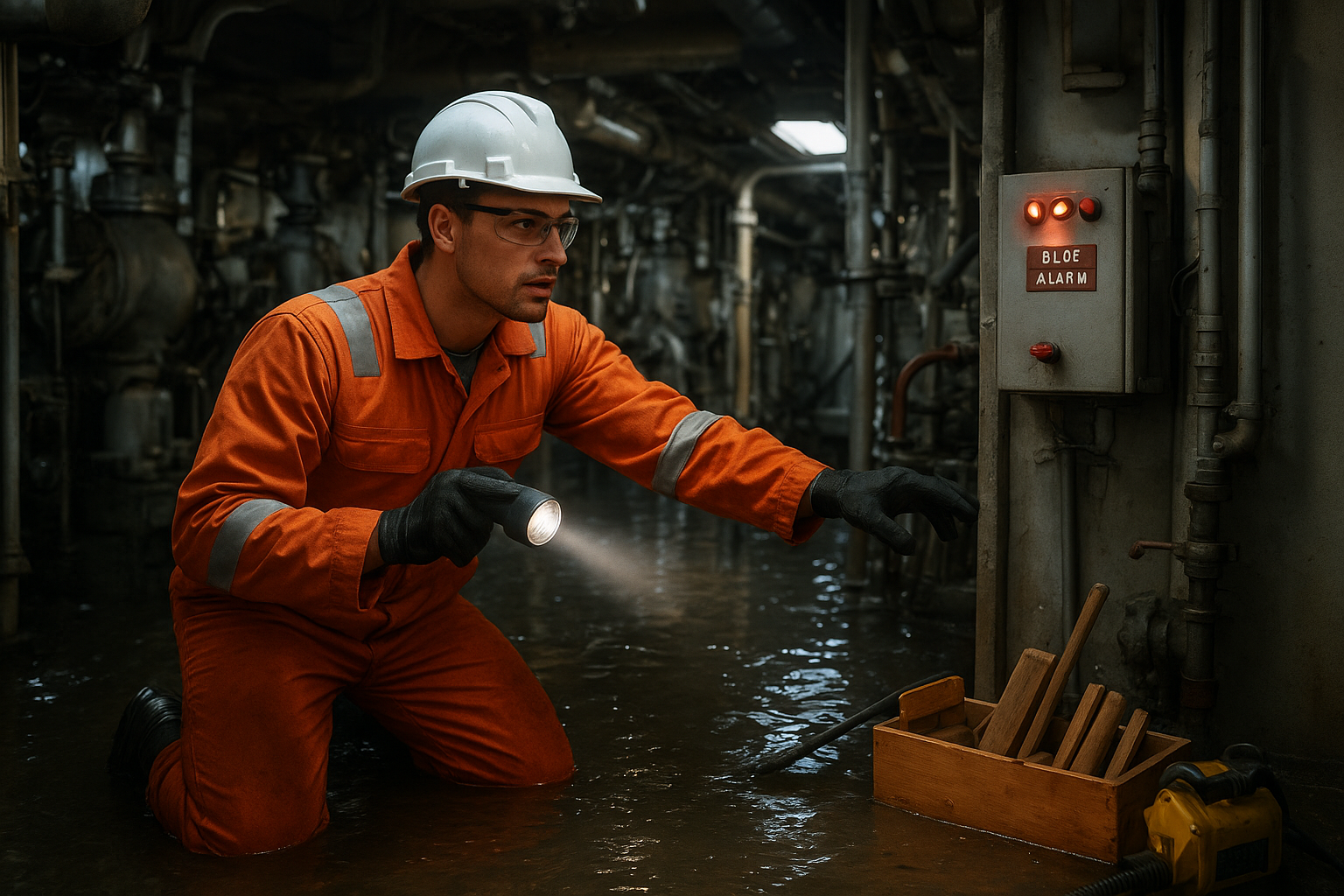
Flooding Emergencies Onboard Ships: Detection, Response, and Damage Control
The Engineer's Worst Nightmare
What Causes Flooding Onboard Ships?
- Seawater valve or strainer cover left open: This happens more often than you'd think. During maintenance, a valve gets left open or a strainer cover isn't properly secured, and seawater starts pouring in.
- Broken welds or structural failures: Over time, the constant stress of the ocean can cause welds to fail or structural components to crack.
- Seawater corrosion: Saltwater is incredibly corrosive. Pipes, valves, and structural components can corrode through, creating holes that let water in.
- Piping system failures: The ship's saltwater piping system can develop leaks, ruptures, or complete failures.
- Equipment failures: Pumps, valves, and other equipment can fail in ways that allow water to enter spaces where it shouldn't be.
The Seawater Strainer Story: A Real-World Example
How We Detect Flooding: The Bilge Alarm System
Engineer Rounds: The Human Detection System
- Visible water or fluid where it shouldn't be
- Unusual sounds that might indicate leaks or equipment problems
- Changes in temperature or humidity that might indicate water ingress
- Equipment that's not operating normally
- Any signs of corrosion or structural damage
- Proper operation of bilge pumps and drainage systems
Emergency Response: When the Alarm Goes Off
- How much water is present?
- Is the water level rising?
- Are multiple bilge alarms going off?
- Is the flooding spreading to other compartments?
- What's the source of the flooding?
Flooding Response: The Step-by-Step Procedures
Damage Control Equipment: The Tools of Survival
- Braces and brackets: Used to shore up damaged structures and prevent further collapse
- Wood blocks: For plugging holes, shoring up damage, and creating temporary barriers
- DC plugs (Damage Control plugs): Wooden cones that can be jammed into leaking holes to stop or slow water ingress
- Sledge hammers: For driving plugs, breaking through damaged areas, or emergency demolition
- Axes: For cutting through damaged materials, clearing debris, or emergency access
- Emergency patches: Various materials for temporarily sealing leaks and holes
- Portable pumps: For removing water from areas where fixed pumps can't reach
Mariner Damage Control Training: Certification and Requirements
- Damage control procedures: How to isolate flooding, use emergency equipment, and coordinate response efforts
- Ship-specific systems: Detailed knowledge of the ship's bilge systems, pumps, valves, and watertight doors
- Emergency equipment operation: How to use portable pumps, emergency patches, and other damage control equipment
- Communication procedures: How to coordinate with the bridge, other departments, and shore-based emergency services
- Stability considerations: Understanding how flooding affects ship stability and what actions to take
- Damage control equipment training: Hands-on practice with DC plugs, braces, emergency pumps, and crossover valve operations
- Simulator training: Realistic scenarios that test mariners' ability to respond under pressure
The Human Factor: Working Under Pressure
Prevention: The Best Defense
- Proper maintenance procedures: Following correct procedures when working on seawater systems, strainers, and other equipment
- Regular inspections: Checking for corrosion, wear, and other problems before they become failures
- Training and awareness: Ensuring that all crew members understand the importance of proper procedures and the consequences of mistakes
- Equipment redundancy: Having backup systems and equipment in case primary systems fail
- Proper documentation: Keeping detailed records of maintenance, inspections, and any problems that are discovered
What's Next: More Emergency Response Articles
- Fire emergencies and firefighting procedures
- Loss of power emergencies and recovery procedures
- Engine room explosions and steam system failures
- High-voltage electrical emergencies and arc flash safety
- Fuel and lube oil emergency containment procedures
The Bottom Line
Share This Article
Related Articles
Continue reading with these related articles

Engineering Emergencies Onboard Ships: When Things Go Wrong at Sea
Discover the most common engineering emergencies onboard ships and how marine engineers are trained to handle them. Learn about fires, flooding, equipment failures, and the critical response procedures that keep ships safe at sea.

Medical Emergencies at Sea: Onboard Medical Facilities and Emergency Medical Response
Discover how medical emergencies are handled at sea, from onboard medical facilities to helicopter medevac flights. Learn about cruise ship medical centers, hospital ships like USS Mercy and USS Comfort, and emergency medical response procedures.

Bridge Safety Equipment: Weather Detection, Radio Communications, and Emergency Beacons
Discover the advanced safety equipment in the ship's bridge, including weather monitoring, communication systems, and emergency positioning beacons that keep ships safe at sea.

Shipboard Emergency Communications Equipment: Radio Systems, EPIRBs, and Satellite Communications
Discover the critical emergency communications equipment onboard ships, from VHF radios and EPIRBs to satellite systems. Learn how ships maintain contact during emergencies and coordinate rescue operations.
© 2025 The Salty Mariner. All rights reserved.
